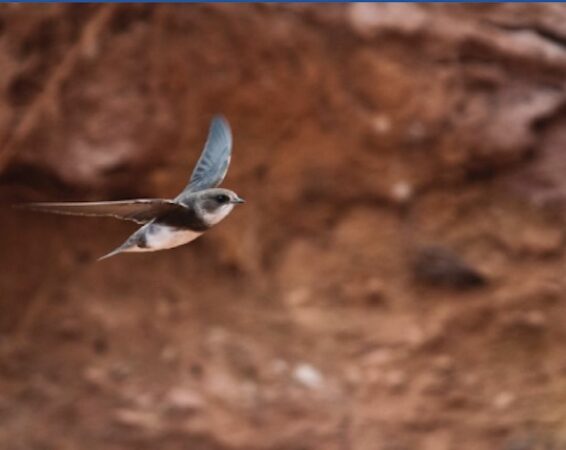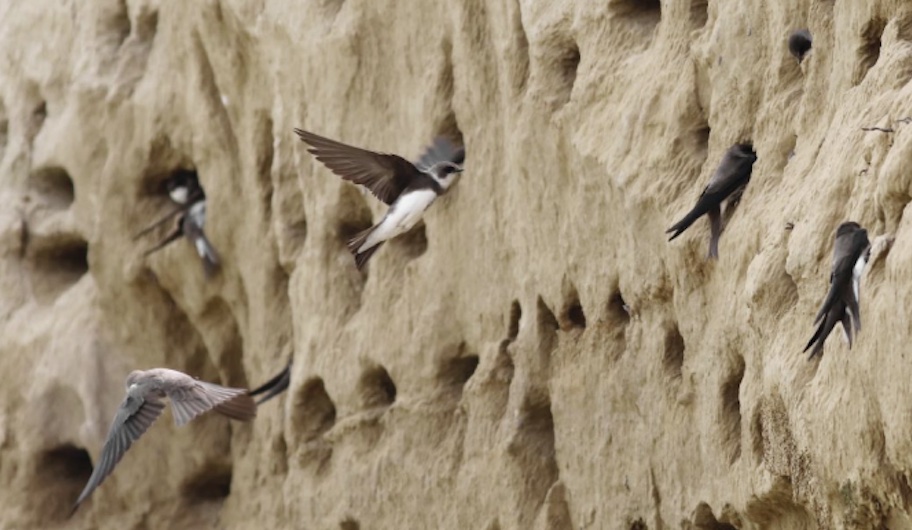
Navigating this threatened species in pits and quarries
Bank swallows in pits and quarries. Do you dig it?
Bank swallows do, too! Bank swallows are federally threatened birds that can make their summer homes in pit and quarry operations. In Canada, bank swallow populations have declined by 98 per cent over the last 40 years. Pit and quarry operators like you can help conserve bank swallow populations.
WHAT ARE BANK SWALLOWS?
Bank swallows are small birds that feed entirely on insects they catch while flying. They have brown upperparts and white underparts with a large brown band across the upper chest. They breed in Canada during our summer months (May to late August) and fly to South America during winter. For nesting, bank swallows dig burrows about 65-cm deep into loose substrate embankments with a near vertical face (70 degrees or more) along ocean coasts, lakes, streams, rivers, and wetlands. They will also nest in human-created habitats such as piles and cut faces in aggregate pits and quarries. Bank swallows are colony nesters with colony sizes ranging from a few individuals to several thousand nesting at one colony. They often return to the same nest site year after year.
WHY ARE THEY DECLINING?
The reasons for declining bank swallow populations are still being researched, but some of the main pressures bank swallows face include the global decline of insects, habitat loss, and climate change. Loss of breeding habitat happens as coastal and inland waterbody banks are covered in rock (rock armouring), overly eroded during the summer, or developed. Artificial slopes (pits and quarries, road banks) provide another potential habitat to this species when there is no summer disturbance. Due to their decline, bank swallows are considered “Threatened” under the federal Species at Risk Act and are protected under the Migratory Birds Convention Act. Under these acts, individual birds, nests, and eggs are protected.
WORKING WITH BANK SWALLOWS?
So, what happens if bank swallows decide to make their summer home at your pit or quarry operation? A few steps can be taken to help keep operations going and protect bank swallows. Before bank swallows arrive (before mid-April): In mid-April, bank swallows arrive in Canada to begin nesting. Before they arrive, in active work areas, you can: • Flatten piles to have slopes less than 70 degrees. This makes the pile unsuitable for nesting bank swallows. • Install scaring devices to deter bank swallows from nesting in active work areas. For inactive work areas (until at least late-August):
- Provide habitat for bank swallows by creating vertical slopes of at least 70 degrees in sand or dirt piles and faces. This will encourage bank swallows to nest in these areas.
During the breeding season (mid-April to late-August):
In active work areas, you can:
- Flatten newly created vertical faces (to have a slope of less than 70 degrees) at the end of each workday and before weekends to prevent the establishment of new colonies.
If a colony establishes in an active work area, you must stop excavation work in that area and cannot use scaring devices at this point. What you can do is:
- Mark off a buffer zone of at least 50 metres around the colony to prevent the burrows from collapsing. This is the minimum recommended distance for a buffer zone, and louder, more intense activities (e.g., blasting) may require larger buffer zones.
- Reach out to Birds Canada to tell us about your active bank swallow colony – we would like to support and thank operators who can provide habitat!

Artificial slopes (pits and quarries, road banks) provide a potential habitat to this
species when there is no summer disturbance. Photo courtesy of Birds Canada
You can excavate the nesting site at the end of the breeding season, after all the birds have left. However, bank swallows will often return to the same nesting site year after year, so we encourage you to provide alternative habitats in inactive work areas the following year by creating piles with a slope of at least 70 degrees.
If your operation is closing and the piles that bank swallows use are still in good condition and do not pose a safety issue, please consider leaving them for future breeding seasons. If you are obligated to rehabilitate your land, we suggest discussing leaving bank swallow habitat with the permitting authority.
WHY CARE?
Bank swallows are an important part of our natural world. They provide direct benefits to you by eating pest insects that can carry diseases, harm crops, and annoy us during our outdoor experiences.
For any questions, contact Heather Polowyk at hpolowyk@birdscanada.org
Print this page
